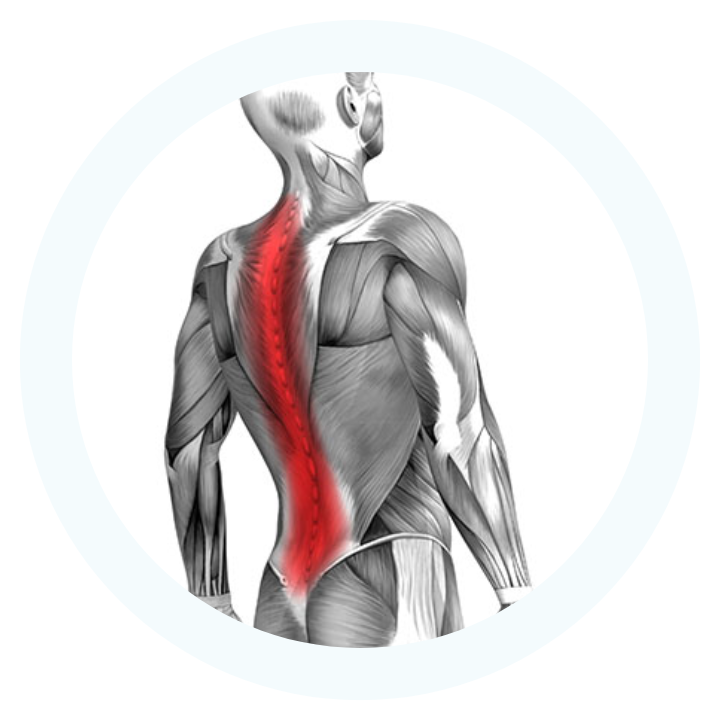Treatment for Thoracic Spine Pain
In Texas


Common Causes of Thoracic Spine Pain
- Herniated Disc : A herniated disc in the thoracic spine occurs when the soft inner gel of a spinal disc leaks out through a tear in the outer layer. This can compress nearby nerves, causing pain, numbness, and weakness.
- Degenerative Disc Disease : Degenerative disc disease involves the gradual breakdown of the spinal discs, leading to pain, stiffness, and reduced mobility in the thoracic spine. This condition is often associated with aging.
- Spinal Stenosis : Spinal stenosis in the thoracic spine occurs when the spinal canal narrows, compressing the spinal cord and nerves. This can lead to pain, numbness, and weakness in the thoracic region and lower extremities.
- Annular Fissure (Disc Tear) : An annular fissure, also known as a disc tear, occurs when there is a tear in the outer layer of the intervertebral disc. This can lead to pain, inflammation, and possible herniation of the disc material, causing nerve compression and pain.
- Compression Fractures : Compression fractures in the thoracic spine often occur due to osteoporosis, trauma, or metastatic cancer. These fractures can cause severe pain and deformity.
- Scoliosis : Scoliosis is a condition where the spine curves abnormally to the side. This can cause thoracic spine pain, particularly if the curvature is severe and affects posture and alignment.
- Kyphosis : Kyphosis is an excessive forward curvature of the thoracic spine, leading to a hunched posture. This condition can cause pain, stiffness, and difficulty breathing in severe cases.
- Facet Joint Dysfunction : Facet joints in the thoracic spine can become inflamed or injured, leading to localized pain and reduced mobility. This is often caused by arthritis or trauma.
- Thoracic Outlet Syndrome : Thoracic outlet syndrome occurs when blood vessels or nerves are compressed in the space between the collarbone and the first rib, causing pain, numbness, and weakness in the thoracic spine, shoulder, and arm.
- Ankylosing Spondylitis : Ankylosing spondylitis is a type of inflammatory arthritis that primarily affects the spine, causing pain, stiffness, and eventual fusion of the vertebrae in the thoracic spine.
- Myofascial Pain SyndromeMyofascial pain syndrome involves the development of trigger points in the muscles of the thoracic spine. These trigger points can cause referred pain and tenderness in the affected area.
Diagnosing Thoracic Spine Pain
Diagnosis of thoracic spine pain involves a comprehensive medical history and physical examination. Imaging tests such as X-rays, MRI, or CT scans may be used to identify the underlying cause. In some cases, blood tests or nerve conduction studies may be necessary to rule out other conditions.

Treatment Options for Thoracic Spine Pain
- Corticosteroid Injections: Injections of corticosteroids into the thoracic facet joint to reduce inflammation and pain, providing relief for various thoracic conditions.
- Epidural Steroid Injections: Epidural steroid injections deliver anti-inflammatory medication directly into the epidural space around the spinal cord, reducing inflammation and pain in the thoracic spine.
- Medial Branch Blocks: Medial branch blocks involve injecting a local anesthetic near the medial branch nerves that supply the facet joints in the thoracic spine. This can help diagnose and relieve pain originating from these joints.
- Radiofrequency Ablation (RFA): Radiofrequency ablation uses heat generated by radio waves to destroy the nerves transmitting pain signals from the facet joints in the thoracic spine, providing long-term pain relief.
- Trigger Point Injections: Trigger point injections involve injecting a local anesthetic into specific points in the muscles of the thoracic spine to relieve pain caused by muscle tension and spasms.
- Platelet-Rich Plasma (PRP) Injection: PRP therapy involves injecting a concentration of the patient's own platelets to promote healing and reduce pain in injured or inflamed thoracic spine tissues.
- Amniotic Injections: Amniotic injections use amniotic fluid or tissue to promote healing and reduce inflammation, providing relief for thoracic spine injuries and degenerative conditions.
- Exosome Injections: Exosome injections deliver regenerative particles that can aid in the healing of damaged thoracic spine tissues, reducing pain and improving function.
- Prolotherapy: Prolotherapy is an injection-based treatment that involves injecting a solution (often dextrose) into the injured or painful area to stimulate the body's natural healing processes, thereby reducing pain and improving function in the thoracic spine.
- Over-the-Counter Pain Relievers: Ibuprofen, acetaminophen, and naproxen can help reduce pain and inflammation associated with thoracic spine conditions.
- Prescription Medications: Anti-inflammatory drugs, muscle relaxants, and pain relievers may be prescribed for severe pain and inflammation in the thoracic spine.
- Anti-Inflammatory Creams: Topical creams containing anti-inflammatory agents can be applied to the thoracic spine to reduce pain and swelling.
- Exercise Programs: Tailored exercises to strengthen the muscles around the thoracic spine, improve flexibility, and restore range of motion.
- Manual Therapy: Techniques such as massage, mobilization, and stretching to relieve muscle tension, improve mobility, and reduce pain in the thoracic spine.
- Acupuncture: Insertion of fine needles into specific points on the body to relieve pain and promote healing, which can be effective for preventing and treating various types of thoracic spine pain.
- Chiropractic Care: Spinal adjustments and manipulations to improve alignment and reduce pain in the thoracic spine, particularly for conditions related to nerve compression.
- Massage Therapy: Techniques to reduce muscle tension, promote relaxation, and alleviate pain in the thoracic spine.
- Transcutaneous Electrical Nerve Stimulation (TENs) Unit: A device that uses electrical currents to stimulate nerves and reduce pain, which can be helpful for managing chronic thoracic spine pain.
- Braces & Supports: Supportive braces and supports can help stabilize the thoracic spine, reducing pain and preventing further injury.
- Ultrasound Therapy: Use of sound waves to promote tissue healing and reduce inflammation, which can help alleviate pain in the thoracic spine.
- Shockwave Therapy: A non-invasive treatment that uses shockwaves to stimulate healing and reduce pain, which can be beneficial for certain types of chronic thoracic spine pain.
Interventional Therapies
Medications
Physical Therapy
Alternative Treatments
Conclusion
Thoracic spine pain can significantly impact your daily life, but with the right approach, it can be effectively managed. Understanding the cause of your pain and working with healthcare professionals to develop a personalized treatment plan can help you find relief and improve your quality of life. If you are struggling with persistent or severe thoracic spine pain, seek medical advice to explore your options for diagnosis and treatment.
